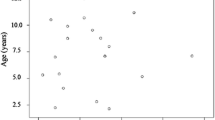Abstract
Introduction
This study was designed to evaluate the incidence of femoral malrotation in bilateral femoral shaft fractures.
Materials and methods
All closed bilateral femoral shaft fractures in patients aged 18 or over treated between April 2000 and December 2009 were included in the current study. All patients received a postoperative CT-scan to estimate femoral antetorsion and leg length. All bilateral fractures were treated with intramedullary nailing on a radiolucent table. Retrospectively, all patients were analyzed according to the following parameters: (1) femoral antetorsion of both limbs and antetorsion difference in degrees, (2) femoral length discrepancy (cm), (3) incidence of femoral malrotation >15°, (4) revision rate due to femoral malrotation.
Results
A total of 24 patients (11 [45.8%] female; 13 [52.8%] male) with bilateral femoral shaft fractures were included in this study of average age 38 years (median 38 years, range 18–74 years). Clinically relevant malrotation (greater than 15°) was found in 10 cases (41.2%), whereas in 4 cases (40%) a revision surgery was required.
Discussion
Bilateral femoral shaft fractures are associated with a high incidence of clinically relevant femoral malrotation over 15°. Measurement of intraoperative femoral antetorsion in bilateral femoral shaft fractures is quite difficult and currently only feasible postoperatively.


Similar content being viewed by others
References
Bjersand AJ, Eastgate RJ (1982) The accuracy of CT-determined femoral neck anteversion. Eur J Radiol 2:1–4
Bonnevialle P, Cauhepe C, Alqoh F et al (2000) Risks and results after simultaneous intramedullary nailing in bilateral femoral fractures: a retrospective study of 40 cases. Rev Chir Orthop Reparatrice Appar Mot 86:598–607
Braten M, Terjesen T, Rossvoll I (1993) Torsional deformity after intramedullary nailing of femoral shaft fractures. Measurement of anteversion angles in 110 patients. J Bone Joint Surg Br 75:799–803
Brumback RJ, Uwagie-Ero S, Lakatos RP et al (1988) Intramedullary nailing of femoral shaft fractures. Part II: Fracture-healing with static interlocking fixation. J Bone Joint Surg Am 70:1453–1462
Citak M, Citak M, Kendoff D et al (2009) Estimation of pretraumatic femoral antetorsion in bilateral femoral shaft fractures. Skeletal Radiol 38:1183–1187
Citak M, Gardner MJ, Citak M et al (2007) Navigated femoral anteversion measurements: a new intraoperative technique. Injury 39:467–471
Copeland CE, Mitchell KA, Brumback RJ et al (1998) Mortality in patients with bilateral femoral fractures. J Orthop Trauma 12:315–319
Doody O, Given MF, Lyon SM (2008) Extremities—indications and techniques for treatment of extremity vascular injuries. Injury 39:1295–1303
Failoni S, Vadala G, Dragonetti L et al (1985) The value of computed tomography in the study of torsion of the lower limbs. Radiol Med 71:409–412
Giannoudis PV, Cohen A, Hinsche A et al (2000) Simultaneous bilateral femoral fractures: systemic complications in 14 cases. Int Orthop 24:264–267
Grote R, Elgeti H, Saure D (1980) Determination of the antetorsional angle at the femur with axial computer tomography. Rontgenblatter 33:31–42
Herzberg W, Meitz R, Halata Z (1991) Antetorsion of the femur neck. A variable of the trochanter minor? Unfallchirurg 94:168–171
Hilgert RE, Ohrendorf K, Schafer FK et al (2006) Preventing malrotation during intramedullary nailing of femoral fractures. Unfallchirurg 109:855–861
Jaarsma RL, Pakvis DF, Verdonschot N et al (2004) Rotational malalignment after intramedullary nailing of femoral fractures. J Orthop Trauma 18:403–409
Jaarsma RL, Verdonschot N, van der Venne R et al (2005) Avoiding rotational malalignment after fractures of the femur by using the profile of the lesser trochanter: an in vitro study. Arch Orthop Trauma Surg 125:184–187
Jend HH (1986) Computed tomographic determination of the anteversion angle. Premises and possibilities. Rofo 144:447–452
Jiang X, Li X, Wang M et al (2002) Measurement of fracture malrotation after interlocking intramedullary nailing of femoral shaft fracture. Zhonghua Wai Ke Za Zhi 40:55–58
Kendoff D, Citak M, Gardner MJ et al (2007) Navigated femoral nailing using noninvasive registration of the contralateral intact femur to restore anteversion. Technique and clinical use. J Orthop Trauma 21:725–730
Kraus R, Meyer C, Heiss C et al (2006) Intraoperative radiation exposure in elastic stable intramedullary nailing (ESIN) during the growth period: observations in 162 long bone shaft fractures. Unfallchirurg 110:28–32
Krettek C, Rudolf J, Schandelmaier P et al (1996) Unreamed intramedullary nailing of femoral shaft fractures: operative technique and early clinical experience with the standard locking option. Injury 27:233–254
Majkowski RS, Baker AS (1991) Interlocking nails for femoral fractures: an initial experience. Injury 22:93–96
Nork SE, Agel J, Russell GV et al (2003) Mortality after reamed intramedullary nailing of bilateral femur fractures. Clin Orthop Relat Res 415:272–278
Raman R, Sidhom S, Pape HC et al (2004) Systemic effects of bilateral tibial versus bilateral femoral shaft fractures. Is there a difference? Acta Orthop Belg 70:134–141
Stephen DJ, Kreder HJ, Schemitsch EH et al (2002) Femoral intramedullary nailing: comparison of fracture-table and manual traction. a prospective, randomized study. J Bone Joint Surg Am 84-A:1514–1521
Tornetta P 3rd, Ritz G, Kantor A (1995) Femoral torsion after interlocked nailing of unstable femoral fractures. J Trauma 38:213–219
Waidelich HA, Strecker W, Schneider E (1992) Computed tomographic torsion-angle and length measurement of the lower extremity. The methods, normal values and radiation load. Rofo 157(3):245–251
Weil YA, Gardner MJ, Helfet DL et al (2007) Computer navigation allows for accurate reduction of femoral fractures. Clin Orthop Relat Res 460:185–191
Winquist RA, Hansen ST Jr, Clawson DK (2001) Closed intramedullary nailing of femoral fractures. A report of five hundred and twenty cases. 1984. J Bone Joint Surg Am A83:1912
Wolinsky PR, McCarty E, Shyr Y et al (1999) Reamed intramedullary nailing of the femur: 551 cases. J Trauma 46:392–399
Author information
Authors and Affiliations
Corresponding author
Rights and permissions
About this article
Cite this article
Citak, M., Suero, E.M., O’Loughlin, P.F. et al. Femoral malrotation following intramedullary nailing in bilateral femoral shaft fractures. Arch Orthop Trauma Surg 131, 823–827 (2011). https://doi.org/10.1007/s00402-010-1245-6
Received:
Published:
Issue Date:
DOI: https://doi.org/10.1007/s00402-010-1245-6




